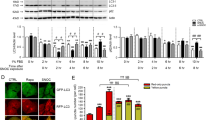Abstract
X-linked inhibitor of apoptosis (XIAP) is a protein that possesses anti-apoptotic function and dysregulation of it has been linked to a number human disease such as cancers and neurodegenerative disorders. In our previous study, we have found that nitric oxide (NO) can modulate the anti-apoptotic function of XIAP and found that this can contribute to the pathogenesis of Parkinson’s disease. Specifically, we found that modification of baculoviral IAP repeat 2 of XIAP by S-nitrosylation can compromise XIAP’s anti-caspase 3 and anti-apoptotic function. In this study, we report that cysteine (Cys) 90, Cys 213 and Cys 327 can be specifically S-nitrosylated by NO. We found that mutations of Cys 90 and Cys 327 affect the normal structure of XIAP. More importantly, we found that S-nitrosylation of XIAP Cys 213 impairs the anti-caspase 3 and anti-apoptotic function of XIAP that we observed in our previous study.




Similar content being viewed by others
References
Vaux DL, Silke J (2005) IAPs, RINGs and ubiquitylation. Nat Rev Mol Cell Biol 6:287–297
Lu M, Lin SC, Huang Y et al (2007) XIAP induces NF-kappa B activation via the BIR1/TAB 1 interaction and BIR1 dimerization. Mol Cell 26:689–702
Suzuki Y, Nakabayashi Y, Takahashi R (2001) Ubiquitin-protein ligase activity of X-linked inhibitor of apoptosis protein promotes proteasomal degradation of caspase-3 and enhances its anti-apoptotic effect in Fas-induced cell death. Proc Natl Acad Sci USA 98:8662–8667
Yang Y, Fang S, Jensen JP, Weissman AM, Ashwell JD (2000) Ubiquitin protein ligase activity of IAPs and their degradation in proteasomes in response to apoptotic stimuli. Science 288:874–877
Gyrd-Hansen M, Meier P (2010) IAPs: from caspase inhibitors to modulators of NF-kappaB, inflammation and cancer. Nat Rev Cancer 10:561–574
Finlay D, Vamos M, Gonzalez-Lopez M et al (2014) Small-molecule IAP antagonists sensitize cancer cells to TRAIL-induced apoptosis: roles of XIAP and cIAPs. Mol Cancer Ther 13:5–15
Chung KK (2010) Modulation of pro-survival proteins by S-nitrosylation: implications for neurodegeneration. Apoptosis Int J Progr Cell Death 15:1364–1370
Nakamura T, Tu S, Akhtar MW, Sunico CR, Okamoto S, Lipton SA (2013) Aberrant protein s-nitrosylation in neurodegenerative diseases. Neuron 78:596–614
Nakamura T, Wang L, Wong CC et al (2010) Transnitrosylation of XIAP regulates caspase-dependent neuronal cell death. Mol Cell 39:184–195
Tsang AH, Lee YI, Ko HS et al (2009) S-nitrosylation of XIAP compromises neuronal survival in Parkinson’s disease. Proc Natl Acad Sci USA 106:4900–4905
Stennicke HR, Salvesen GS (1999) Caspases: preparation and characterization. Methods 17:313–319
Cook JA, Kim SY, Teague D et al (1996) Convenient colorimetric and fluorometric assays for S-nitrosothiols. Anal Biochem 238:150–158
Wan OW, Chung KK (2012) The role of alpha-synuclein oligomerization and aggregation in cellular and animal models of Parkinson’s disease. PLoS ONE 7:e38545
Jaffrey SR, Snyder SH (2001) The biotin switch method for the detection of S-nitrosylated proteins. Sci STKE 2001:PL1
Shiozaki EN, Chai J, Rigotti DJ et al (2003) Mechanism of XIAP-mediated inhibition of caspase-9. Mol Cell 11:519–527
Srinivasula SM, Hegde R, Saleh A et al (2001) A conserved XIAP-interaction motif in caspase-9 and smac/DIABLO regulates caspase activity and apoptosis. Nature 410:112–116
Acknowledgments
This work was supported by Hong Kong Research Grants Council Theme-based Research Scheme (T13-607/12R), HKUST10/CRF/12R, DAG12SC03S and HKUST12/CRF/13G.
Author information
Authors and Affiliations
Corresponding author
Electronic supplementary material
Below is the link to the electronic supplementary material.
10495_2015_1087_MOESM1_ESM.eps
Supplementary material 1 Figure S1. Mutation of Cys90 of XIAP does not affect its E3 ligase activity but reduce its solubility. (A) HEK293T cells transfected with myc-tagged C90H XIAP and HA-Ub were incubated with or without 100 μM NOC18 for 24 h. The cells were then harvested and anti-myc antibody immunoprecipitation was performed on the soluble fraction followed by Western blot analysis to assess the E3 ligase activity of C90H XIAP. (B) Insoluble fraction of (A) was solubilized as described in the method section. The solubility of C90H XIAP was reduced as in Figure 1 B. (C) HEK293T cells transfected with myc-tagged C327H XIAP and HA-Ub were incubated with or without 100 μM NOC18 for 24 h. The cells were then harvested and anti-myc antibody immunoprecipitation was performed on the soluble fraction followed by Western blot analysis to assess the E3 ligase activity of C327H XIAP. No myc-tagged C327H XIAP was detected after immunoprecipitation. (D) Insoluble fraction of (C) was solubilized as described in the method section. The solubility of C327H XIAP was greatly reduced as in Figure 1 A (EPS 5647 kb)
Rights and permissions
About this article
Cite this article
Wu, W., Wan, O.W. & Chung, K.K.K. S-nitrosylation of XIAP at Cys 213 of BIR2 domain impairs XIAP’s anti-caspase 3 activity and anti-apoptotic function. Apoptosis 20, 491–499 (2015). https://doi.org/10.1007/s10495-015-1087-3
Published:
Issue Date:
DOI: https://doi.org/10.1007/s10495-015-1087-3




